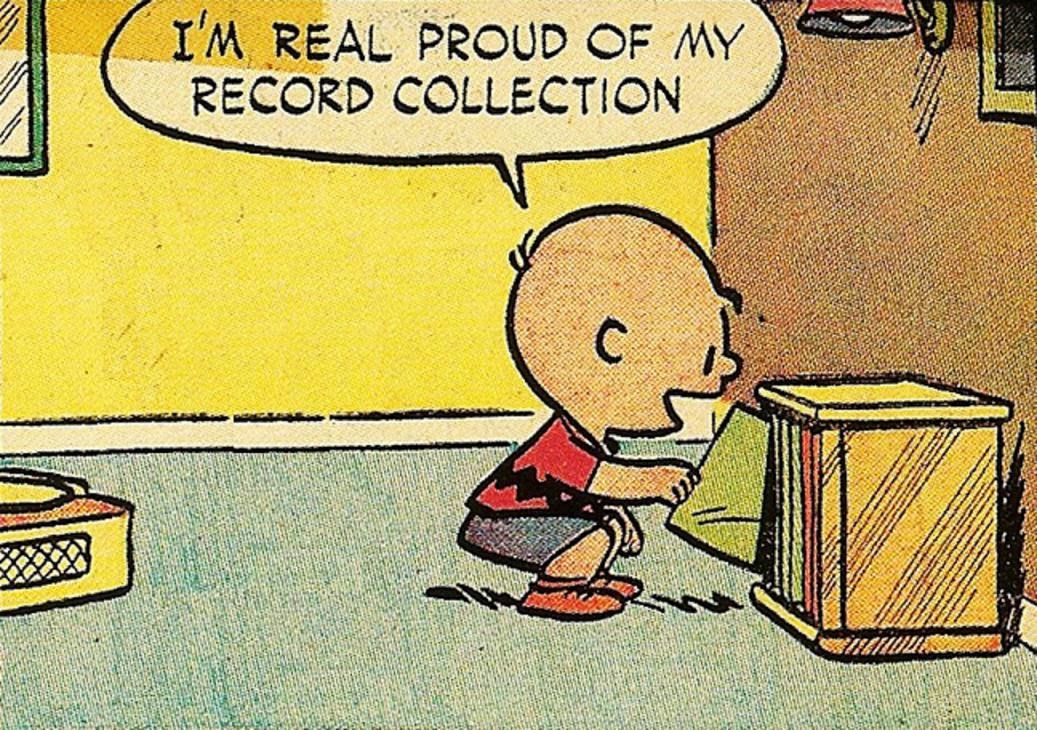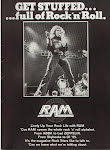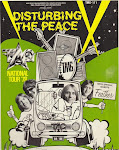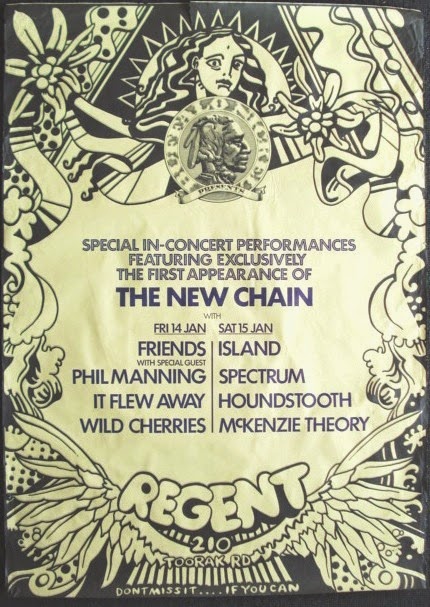The U.K. version of Are You Experienced has the perfect album opening, the sound of Hendrix scraping his pick down a string to produce the effect of his guitar emerging from the aural distance, gradually increasing in volume and then exploding-with a flare of feedback-into "Foxy Lady's" sublimely lecherous riff.
Hendrix's riff is not the staccato work that is beloved by heavy metallers, but one that utilizes the qualities made possible by his cranked-up amps to create a delightfully rippling and continuous sound. Furthermore, Hendrix enriches even that unusually exotic palette by throwing in the occasional flourish, the bright, trebly, solid-bodied sonic qualities of which are a deliciously startling contrast to those of that thin, growling lick.
An additional contrast to the type of heavy metal with which Hendrix's music is, ludicrously, so often associated is the sweetness of his manner and sentiments. "Foxy Lady" is without doubt a song about sex. Decades of rock singers' braggadocio has made us automatically assume that speaking or singing about sex equates with boastfulness or oppressiveness. To celebrate the pleasures of intercourse is a perfectly natural human desire, for both men and women. "Foxy Lady" does precisely and merely that-and when Hendrix sings "I'm coming to git ya," he is being playful, not predatory.
The absence of "Wild Thing" on his debut album might very well be explained by this opening track. Surely, "Foxy Lady" is Hendrix's rewriting of that Chip Taylor classic. Though there is no direct plagiarism, the common attributes of the two songs are so significant as to seem to rule out coincidence. "Wild Thing" and "Foxy Lady" are both compositions with a great blaring dirty riff , a stop-start structure, and an unashamedly horny ambience.
Manic Depression
"Manic Depression" is the finest example of the excellence of the Experience as a group and the ultimate proof of the idiocy of the opinions of the likes of Nik Cohn. On "Manic Depression," all three members of the Jimi Hendrix Experience are operating as equals. Hendrix's playing is of the elevated nature one takes for granted with him, but the rhythm section is on fire. Mitchell's drums are heart-stopping in both their thunder and their relentlessness. Redding's playing, meanwhile, is sublime: when Hendrix pauses each time before singing the line about what manic depression is doing to him (effectively the chorus of the song), Redding shatters the silence with brawny, climbing basslines that are utterly fabulous.
Those who thought "Purple Haze" was pushing the envelope in terms of volume, distortion, and sheer musical belligerence must have been astounded that, on this track, not only was the Experience able to go further in all of those areas, but actually went considerably further. "Manic Depression" is brutally aggressive and colossally loud. It never lets up in its determination to make as much noise as possible' even those pauses before the title refrain vocal line are splintered by an unyielding Redding. Nothing-not the Velvet Underground's clangorous experimentation on its first album (released a couple of months before the release of Are You Experienced), not Dave Davies's amp-shredding performance on "You Really Cot Me" in 1964 - had ever sounded this extreme before.
And yet, the song at no point threatens to become unlistenable. A keen musicality is evident at every juncture. The Experience may not have sat down and plotted each counterpoint and contrast - they weren't that kind of band - but the song is superbly structured. Instruments drop away and inflections are introduced in an intricate arrangement that is the antithesis of a featureless aural assault. In addition to the contrasts within the instrumentation is the extreme counterpoint the lyric (and the melody it rides on) provides to the artillery shell music. "Manic Depression" is not the song of self-assertion implied by its music. Its words are insecure ruminations, frequently almost muttered by Hendrix. At the ends of verses, Hendrix's voice rises climatically (something required by the swelling melody line), but by the beginning of the next verse is back to a mumbled hesitancy, appropriately mirroring the way somebody in the emotional doldrums will determine to do something to improve his situation and then deflate in a confidence-draining second.
As the song careens toward a close, Hendrix and Mitchell indulge in a bout of call and response, throwing the gauntlet of sonic outrage back and forth to each other. Then Hendrix signals that it's time to bring proceedings to a finish with a note on the guitar that is just a little too earsplitting and distorted to be called keening. Mitchell takes the cue with some climatic kit explorations, while Hendrix brings the song home with incrementally descending single notes. The track ends in a gentle rush of feedback and exhausted cymbal splashes.
"Love or Confusion" is the first track on Are You Experienced that is not built upon recognizable musical foundations.
Although the songs hitherto have all been experimental in their own ways, this composition is almost otherworldly in its unusualness. Its departure from the preceding tracks is almost jarringly apparent from the first note: a trebly single guitar strum, which is followed by some bass work from Redding that is disconcertingly reminiscent of a human pulse, followed by the introduction of drumming mixed in such a way as to make Mitchell sound as though he is far off in the distance, yet still clearly audible. The surreal and exotic feel is then deepened by Hendrix's subsequent guitar work, it's as though not guitar notes, but sparkles and comet flares are dancing before us. To cap it all, when Hendrix starts singing, he sounds as if he is standing atop a mountain overlooking a canyon of which we, the listeners, are at the bottom, his words traveling down to us through a series of echoes.
It doesn't stop there. The track is an incredibly heady concoction of variations of color and texture: undulating guitar parts-all with different tones-over lap and interlock and separate again. One guitar part provides a quiet howl of feed-back at regular junctures and, miraculously, sounds no less musical than the track's conventional guitar work. When an interlude occurs, up pops another amazing part: a scraped guitar string, whose quiet, continuous rasping quality is like some kind of small engine warming up. Mitchell's circular drumming patterns echo Hendrix's lyric, which refers to the narrator's mind going 'round and 'round as he tries to solve the puzzle about the mental state expressed in the song's title.
The mundanity of such a dilemma is undermined by the fact that Hendrix is referring to such things as reaching up and touching the sun. Behind everything, there is Redding who-every time he becomes audible-is contributing that very slightly disquieting pulsing.
This track is not just a song, it is an aural painting. Everything in it is used to color and shade and provide perspective (and then make nonsense of perspective). It's a triumph not only for the group, but for the producer and engineer. And yet, though it is obviously a track that simply could not have been made without modern-day electric instruments and cutting-edge studio technology, there is something about "Love or Confusion" that seems utterly ancient. How mind-blowing all this must have been to the audience of 1967.
I Don't Live Today
No one, absolutely no one, could have maintained the sheer staggering brilliance of this album first five tracks, so it would be absurd to be disappointed or surprised that the following song, "I Don't Live Today" (the last track on side one of the original vinyl release) constitutes a slight falling away of quality.
Inevitably, there are several good things about this track. Hendrix's lyric is excellent. When he says he wishes that somebody would hurry up and rescue him so that he can be on his "miserable way," he is superbly, and with great economy of words, evoking despair, whether that despair be an individuals or the despair of a devastated and brutalized race. There are several sublime musical elements, too. Hendrix's guitar break has a nice liquidly quality to it. Mitchell's drumming is, as ever, never less than thoroughly imaginative. His dropped beats create a pleasantly disorienting lag effect. When he resumes a normal signature as he moves with Hendrix into the instrumental break, his drumming matches Hendrix's guitar work for gorgeous fluidity.
Yet the bad outweighs the good. Hendrix always had a masterful ability to make a brutal riff sound attractive, "Purple Haze" being the classic example. Yet the six-note lick on "I Don't Live Today" fails to delight in the same way. Its unimaginativeness is the very opposite of the incredible sonic invention of "Purple Haze," and the licks repetition almost becomes irritating. What sinks the track ultimately is the feed back. The way that the wails of Hendrix cranked-up guitar rush into the listener's face is presented as interesting in its own right, yet Hendrix doesn't do anything clever with it as he does on the previous track, nor does he incorporate it into the melody or arrangement. The track ends up as frequently form-less and often comes perilously close to being a din.
3rd Stone From The Sun
At half of its length, "3rd Stone from the Sun" would have been a very good, dreamy instrumental interlude before the album's punchier remainder. The song is fatally weakened, however-and the entire album sustains a flesh wound because it not only outstays its welcome but, in that extraneous playing time, mistakes technical innovation for aesthetic worth.
The track starts out well, like a Shadows instrumental brought into the space age: just as Hank Marvin explored the possibilities of lead guitar lines on the Stratocaster, presenting lines that were interesting in their own right-not just scene-setting for a vocal-on hits such as "Apache" and "FBI," so does Hendrix in the first couple of minutes of "3rd Stone Redding's bass commands equal attention' the melody he is playing bears no relation to that of the guitar, thus presenting an alternative option in the unlikely event that some might not want to listen to Hendrix's fretwork.
Then things begin to go wrong. As though the two are trying to cancel out the qualities of their playing for the first few minutes, Redding's bass figures become repetitive and overly simple, and Hendrix's feedback and backward experiments lose sight of the first standard of music: listenability. The listenability factor is also affected by the fact that-unthinkable on all other tracks-one looks at one's watch. Because the soporific nature of "3rd Stone." couldn't be a more unfortunate contrast to the way that every other song crackles and bristles with energy, it results in a profound slowing of the album's momentum. This might have been redeemed at the time by the novelty of the noises Hendrix was making, but 35 years later we are left with what some consider a boring period piece.
Remember
Following "3rd Stone ." as it does (on the U.K. version of the album, at any rate), the conventionality of "Remember" is thoroughly refreshing, although it's not only by comparison that this song triumphs. "Remember" is a ludicrously underrated song in the Hendrix canon. Yes, it is an R & B number (although had the word been more common then it would have been labeled soul) that lovingly embraces all the traditions of that genre-from its strident melody to its punchy rhythm to its use of the mockingbird motif-but it is in no way pedestrian.
Hendrix delights in the traditions of the type of song he had once played night after night on the Chitlin circuit, but he does so with the aid of a superb backing band and his own inimitable inventiveness. These make all the difference. The melody is simply delicious and makes for a wonderfully fresh and exuberant sound. That, and a lyric that holds out hope in the face of desertion, results in a track that, like many great love songs, has a sunny and life-affirming quality despite its sad tale. of course, it's Hendrix's guitar playing that also lifts the track above the merely generic, those distinctive Hendrix qualities of quicksilver patterns and colossal volume serve to make of the form something that is grander and more resplendent, as though the genre has been dressed up in sonic ruffles and bows.
The only black mark is a minor one: after Hendrix says that before his baby left him his mockingbird used to sing so "sweet," shouldn't the next line end with "week" rather than the non-rhyming "day"?
One should be suspicious of Hendrix fans who dismiss the likes of "Remember." Not only do their views smack of self-conscious edginess, they also betray a lack of understanding of both Hendrix the musician and Hendrix the man: "Remember" is no less quintessentially Hendrix than "Purple Haze."
The placing of "Remember" (in the U.K. album version) in front of the albums title and closing track neatly-and startlingly-shows just far Jimi Hendrix had come in the space of less than a year. If "Remember" represents Hendrix's roots, "Are You Experienced" demonstrates how he built upon those roots to take his music into the stratosphere. "Remember"-and all the songs like it that Hendrix had performed in 101 dim and dark venues on the Chitlin circuit-is performance. "Are You Experienced" is creation: the use of instruments to paint an aural picture. Integral to this is the obtaining from those instruments not their expected sounds, but the sounds you would least expect-and integral to that are production effects.
The track fades in. A fluttering backward guitar part (sounding uncannily like modern-day deejay scratching techniques) provides a fanfare for spangled guitar work and a very heavy percussive track. Hendrix's vocal, which occurs almost immediately, is both intimate (he's speaking in the second person) and distant (he doesn't waste time with formalities as he begins to almost hector the listener). Hendrix is encouraging the listener to become an initiate. Of what, however, is unclear. He could, of course, easily be talking about drugs (although he provides room for ambiguity with the final line' "Not necessarily stoned, but beautiful.") or, just as easily, he could be referring to sex.
Then again, the song might be meaningless-the result of a whimsical desire to provide a sort of theme tune for a band called the Experience. It's irrelevant, both the lyric and the music are impressionistic. Shimmering strands of interweaving sounds in various degrees of focus dance across the rhythmic backdrop of shuffling backward rhythm guitar and quasi-militaristic drumming. The wheezing, fluttering backward guitar solo is truly stunning and clearly well thought out: the arbitrary sequences of noise that usually resulted from the tactic in this era would not have been so easy on the ear.
Whatever its considerable qualities, however, the album could have done with a less fey closer-something with more of an impact than this musical equivalent of a view through a kaleidoscope.
"Hey Joe" sounds unlike anything else in Hendrix's canon, but, to the credit of the band (and Chandler) seems any- thing but the flag of convenience and foot-in-the-door tactic it was. In his rendition of Billy Roberts' tragedy (filtered through Tim Rose's vision), Hendrix manages a remarkable feat' to create the definitive reading of a song that anybody and everybody (a lot of them supremely talented) had already tackled.
Strangely, the opening guitar figure and the rest of the song are almost like two un-matching components, the intro is so sudden, dramatic, and dagger-sharp, it makes one expect something altogether more searing and up-tempo than the downbeat affair that follows. It's no matter, though, for the subsequent performance is exquisite in its brooding atmosphere and mood of defiance. Mitchell deserves much of the credit here. He adroitly sidesteps the problems many drummers face as to what to play on slow songs, crashing about his kit but doing it with such care and intelligence as to not destroy the mood in any way. Conceptually, the track's ending is magnificent (if probably unintended), Hendrix saying that no hangman is going to put a noose around his neck as the track is faded out paints a picture of a man disappearing into the distance-utterly opposite for a protagonist on the run. Hendrix's singing here and everywhere else on the track would be impressive in any case, but knowing how shy and insecure he was about his vocals then, his passion and presence takes on another dimension.
"Purple Haze" was as great a departure from Hendrix's debut as could possibly be imagined. "Hey Joe" is, in terms of both theme and musical style, gritty reality. "Purple Haze" drives a coach and horses through the very concept of reality. The first bars are lumbering, dinosaur footsteps. Then the dinosaur speaks in the form of a gargantuan, growling riff, with Mitchell shadowing it for emphasis. The riff moves seamlessly into a swinging rhythm guitar part, the type of which Hendrix specialized in at the time: a supple, melodic, multiple-stringed affair-with outer margins blurred by distortion-that is far removed from the stabbed rhythm guitar style common at the time, yet avoids the equally unimaginative wall-of-sound rhythm guitar that is fashionable nowadays.
The lyric-whose rendition is EQ'ed to make it sound like Hendrix is declaiming from Mars-is genuinely poetic and clever. Overfamiliarity has dulled us to its charms, but just think about that frisson of delight you experienced the first time you heard Hendrix say-in an insane aside to the listener - "Scuse me while I kiss the sky!" The guitar solo is a stream of molten gold followed by some heavy breathing and the repetition of that growling riff once more. Another verse of grand-scale bewilderment-the protagonist, rather than not knowing what day of the week it is, is instead confused as to whether the time space he occupies is tomorrow or the end of time-and soon we reach the end of the song, a fade where the molten gold guitar tone, counterpointed by some fine rocket-ship-engine bass, once again reigns.
"The Wind Cries Mary" boasts probably Hendrix's finest lyric. All the studying at the feet of Bob Dylan came together in a track that could pass for the missing verses of "Desolation Row." The two lines that counterpoint a queen weeping and a king having no wife are the high points of a song that is packed with dazzling imagery.
The music, however, is not as beautiful as the words-at least, if one hears it in stereo.
This author remains unconvinced of the claims for the superiority of the mono versions of Are You Experienced tracks, but without doubt, Mary gains power in that mix. Hendrix's guitar playing is a rather rude presence in stereo-emphasizing how his three-note descending part at the end of each verse is unimaginative by his standards-but in mono, everything slips into focus, especially his lovely, warm singing. The music is a little too stiff, unfortunately. Improvisation generally worked for the Experience, but here, the lack of suppleness inherent in first takes is just a little too evident. [extract from 'Not Necessarily Stoned, But Beautiful' by Sean Egan, Unanimous Ltd, 2002. p185-202]
























































